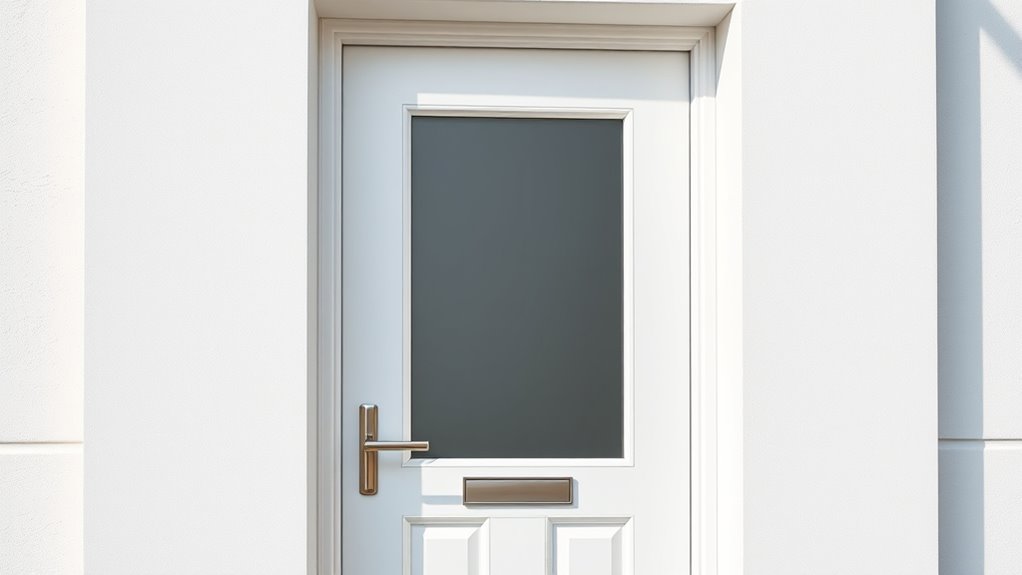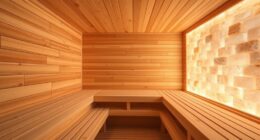Proper door placement can markedly reduce heat loss in your home. Position exterior doors where they’re sheltered from strong winds and avoid open, exposed locations. Insulate doors well and use weatherstripping to seal gaps. Inside, placing doors strategically can help stop heat from escaping between rooms. Combining these strategies with quality materials ensures better energy efficiency. To discover more tips on optimizing door placement for warmth, keep exploring ways to improve your home’s insulation and design.
Key Takeaways
- Placing exterior doors in shaded, sheltered areas reduces heat loss and improves energy efficiency.
- Proper insulation and weatherstripping around doors prevent drafts and minimize heat transfer.
- Strategic interior door placement can limit unwanted heat flow between rooms, enhancing overall home efficiency.
- Installing doors away from high wind exposure and using wind barriers decreases infiltration and heat loss.
- Selecting energy-efficient door materials and ensuring proper installation further reduces drafts and thermal bridging.
How Does Door Placement Affect Heat Retention?
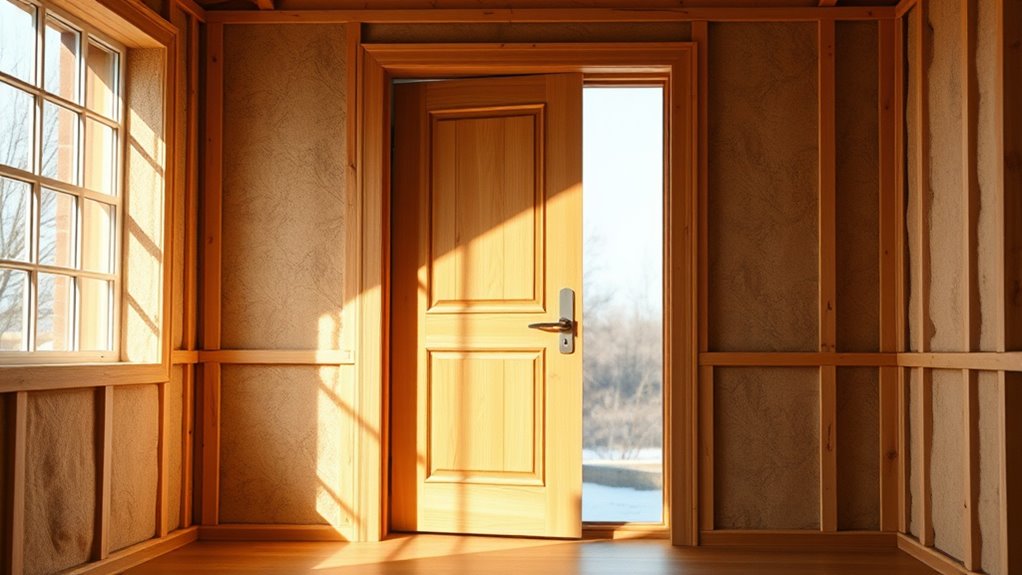
Door placement plays a crucial role in how well your home retains heat. Positioning exterior doors in shaded or less exposed areas can reduce heat loss, especially during colder months. Proper door insulation is essential; it helps prevent drafts that cause heat to escape. Installing thermal curtains over doors adds an extra barrier, trapping warm air inside and blocking cold drafts. Strategic placement near windows or in areas with high wind exposure can make a significant difference in overall heat retention. Keep in mind that doors in drafty spots or poorly insulated locations allow heat to escape more easily, increasing your heating costs. Effective insulation around doors and proper sealing techniques further enhance heat retention. Thoughtful door placement, combined with thermal curtains and good insulation, maximizes warmth and keeps your home cozy longer.
What Are the Best Locations for Exterior Doors to Minimize Heat Loss?
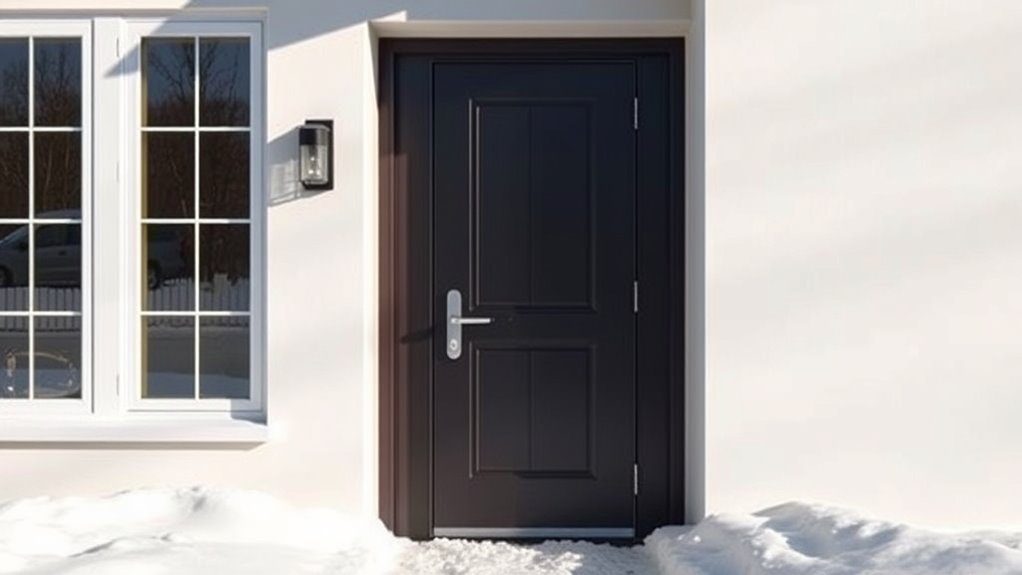
To minimize heat loss, placing exterior doors in sheltered areas away from prevailing winds makes a considerably noticeable difference. Proper door insulation and reducing thermal bridging are essential. Consider these locations:
- Side walls sheltered from wind: Placing doors here minimizes drafts and heat escape.
- Behind landscaping or structures: Using shrubs or fences creates a barrier against wind, reducing heat loss.
- Avoid exposed, open areas: Doors in exposed locations are prone to more wind infiltration, increasing heat transfer.
Additionally, installing well-insulated doors helps prevent heat loss, while careful attention to thermal bridging at door frames reduces cold spots. Ensuring cybersecurity vulnerabilities are addressed in home automation systems can also help prevent unauthorized access to smart home controls that might affect energy efficiency. By choosing ideal locations and ensuring good insulation, you can greatly improve your home’s energy efficiency and comfort.
How Can Interior Door Placement Impact Overall Home Efficiency?
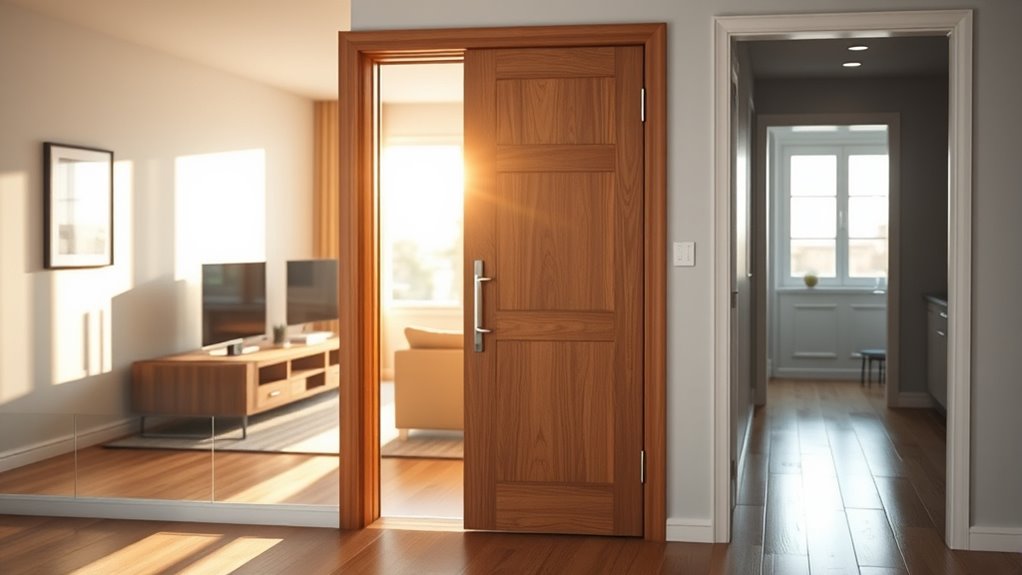
Strategic interior door placement plays a significant role in enhancing your home’s overall energy efficiency. Carefully positioning doors within your home can reduce heat transfer between rooms, especially when doors are kept closed in colder months. Consider the door frame locations to prevent heat from escaping or entering unwanted areas. The door swing direction is also important; a door that swings into a heated room can help retain warm air, while swinging outward might improve airflow and ventilation. Proper placement minimizes drafts and helps maintain consistent temperatures throughout your home. Avoid placing doors in high-traffic or draft-prone areas, as this can lead to unnecessary heat loss. Well-planned interior door placement supports better insulation, reducing your energy bills and increasing comfort year-round. Additionally, door placement can influence how effectively your home utilizes heating and cooling systems, further optimizing energy efficiency.
Are There Design Strategies to Reduce Air Leakage Around Doors?
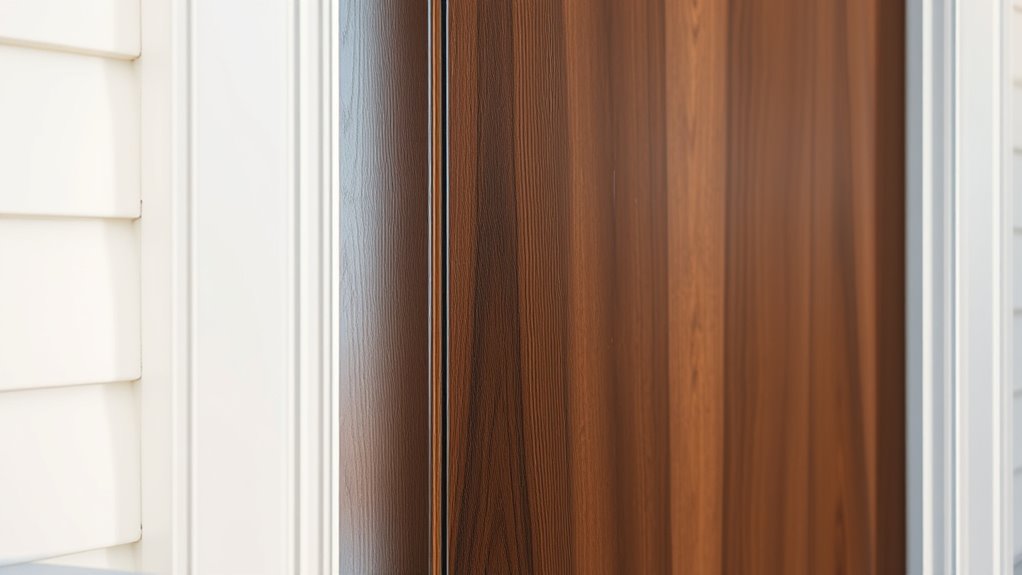
Reducing air leakage around doors is vital for improving your home’s energy efficiency and comfort. To achieve this, consider these design strategies:
Reducing air leakage around doors enhances energy efficiency and home comfort.
- Install high-quality weather stripping to create a tight seal when the door is closed.
- Use door seals along the edges to prevent drafts and air infiltration.
- Ensure proper door alignment and fit, adjusting hinges and thresholds as needed.
- Regular inspection and maintenance of seals can prevent door-related heat loss.
These measures help minimize drafts and heat loss. Weather stripping and door seals are essential for sealing gaps and cracks around your doors. Regularly inspecting and replacing worn or damaged seals keeps your home more energy-efficient. Proper door installation and maintenance make a noticeable difference in reducing unwanted air exchange, keeping your indoor environment comfortable and lowering heating or cooling costs.
What Materials and Features Help Doors Improve Energy Efficiency?
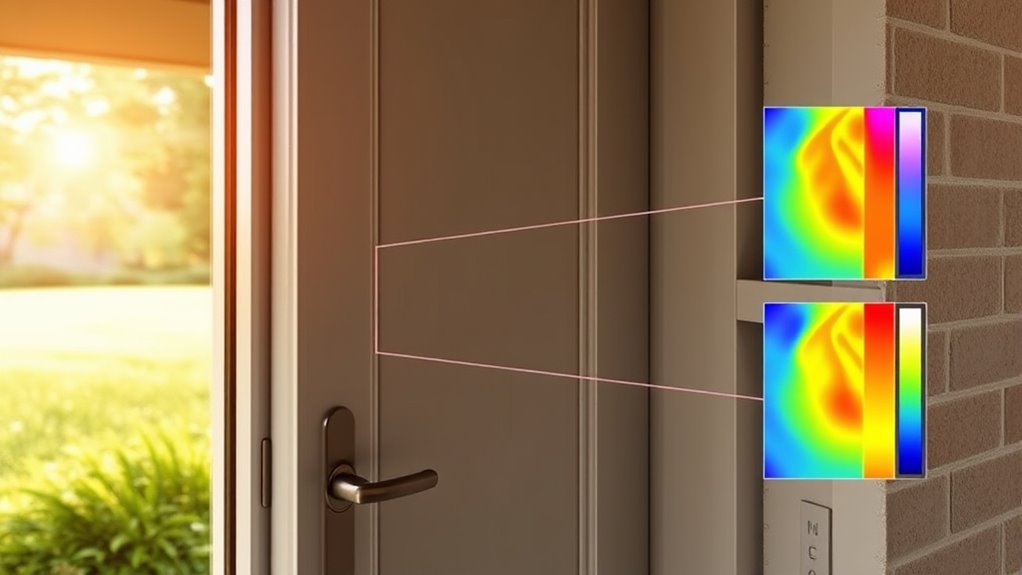
Choosing the right materials and features for your doors can markedly boost their energy efficiency. Opt for doors with high-quality door insulation, which minimizes heat transfer and keeps indoor temperatures stable. Materials like fiberglass, steel, or insulated wood are excellent choices for reducing heat loss. Additionally, implementing effective weatherstripping techniques around the door frame seals gaps that could let in cold air or escape warm air. Proper weatherstripping enhances the door’s airtightness, further improving energy efficiency. Look for doors with built-in insulation or add foam cores for extra thermal protection. Proper installation methods also play a crucial role in ensuring that these features function effectively. Combining these materials and features ensures your door resists heat transfer and air leakage, helping you save on energy costs and maintain a comfortable indoor environment year-round.
Frequently Asked Questions
How Does Door Placement Influence Heating and Cooling Costs Over Time?
Door placement considerably impacts your heating and cooling costs over time. If you position doors near insulation gaps or in drafts, you’ll lose more heat or cool air, increasing energy bills. Choosing the right door material, like insulated or solid options, helps maintain temperature. Proper placement minimizes drafts, reducing energy consumption and costs. So, carefully consider door location and material to keep your home energy-efficient and comfortable year-round.
What Role Do Door Thresholds Play in Preventing Heat Transfer?
Think of door thresholds as your home’s gentle gatekeepers. They play a vital role in preventing heat transfer by sealing gaps where warm or cool air might sneak through. Using quality threshold materials and proper door insulation creates a snug barrier, reducing drafts. This not only keeps your home comfortable but also lowers energy costs over time. A well-chosen threshold is your home’s subtle yet powerful defender against unwanted temperature exchange.
Can Smart Door Technology Improve Energy Efficiency?
Yes, smart door technology can boost your home’s energy efficiency. With smart sensors, your door can detect when it’s open or closed, preventing unnecessary heat loss. Energy monitoring features let you track how much energy is used, helping you identify areas for improvement. By automating door functions and providing real-time data, smart technology reduces energy waste, saves money, and keeps your home more comfortable.
How Do Seasonal Changes Impact Optimal Door Placement Strategies?
Seasonal changes markedly influence your door placement strategies. In colder months, you should prioritize seasonal insulation around doors to prevent heat loss. During winter, position doors to minimize drafts and avoid areas with high wind exposure, which helps prevent drafts. In summer, consider placement that reduces heat gain. Adjusting door placement seasonally guarantees ideal insulation and draft prevention, keeping your home comfortable and energy-efficient year-round.
Are There Specific Door Designs Recommended for High-Traffic Areas?
You should choose door designs made from durable materials like steel or fiberglass for high-traffic areas, as they withstand frequent use. Opt for doors with good insulation to prevent heat loss and maintain energy efficiency. Consider doors with reinforced frames and smooth operation features to handle constant opening and closing. Prioritizing sturdy door materials and quality insulation guarantees longevity and energy savings, even in busy spaces.
Conclusion
By carefully considering door placement and choosing energy-efficient materials, you’re opening the door to a warmer, more comfortable home. Every strategic decision acts as a barrier against the chill, symbolizing your commitment to a cozy sanctuary. When you prioritize these details, you’re not just reducing heat loss—you’re creating a refuge from the cold outside, a symbol of your effort to protect and nurture your space. In doing so, you turn your home into a beacon of warmth and security.
